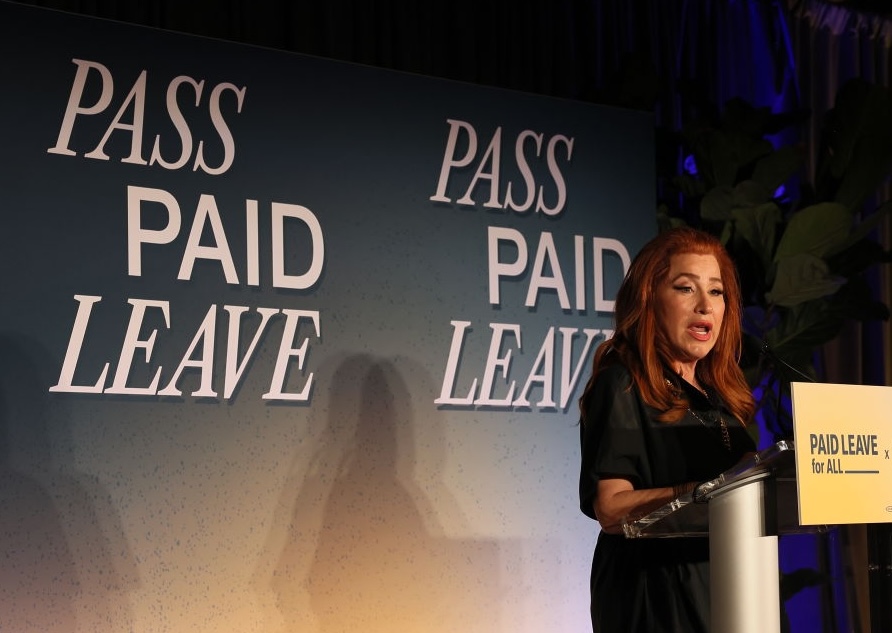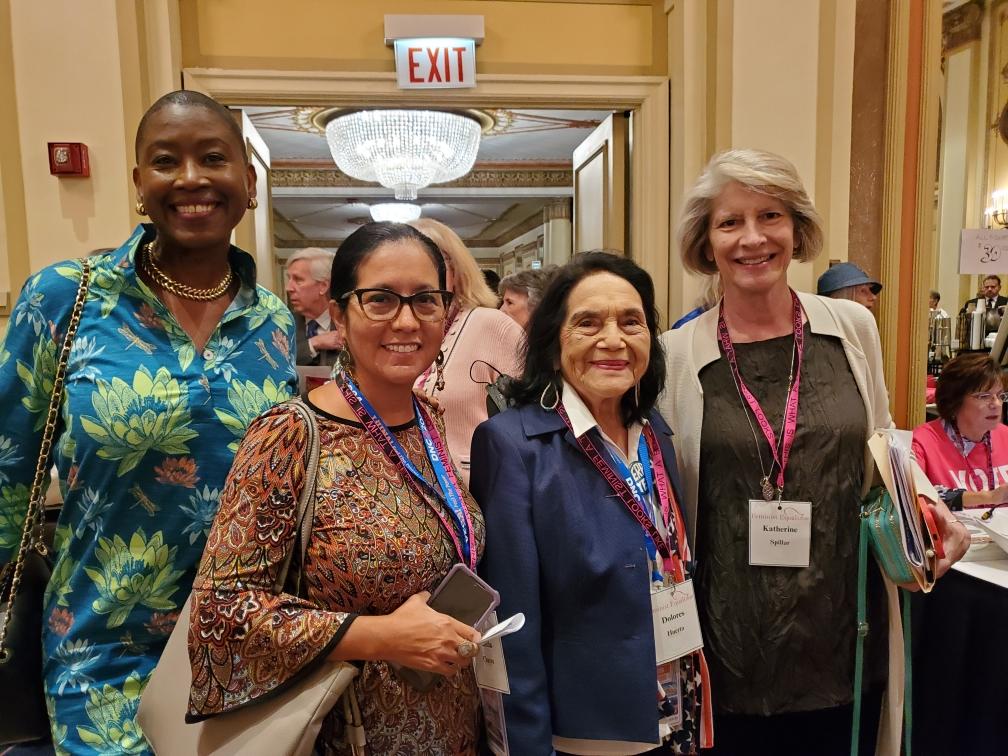Ahead of a high-stakes election, the fight to add women to the Constitution continues.

Lisa Ann Walter first marched in support of the Equal Rights Amendment and abortion rights when she was a kid growing up in suburban Washington. “That was just what my family did,” she said.
More than half a century later, the actor—who currently co-stars in the TV sitcom Abbott Elementary—is still fighting.
For the exact same things.
“I consider it my duty as an American and as a woman to try to do anything I can to continue to move forward,” she told me in an interview at the Democratic National Convention. “We’ve already gone through a lot of this shit once. We’re going to have to scrape and claw our way back.”

Ever since the Supreme Court overturned Roe v. Wade two years ago, the battle to restore abortion rights has been front and center, particularly this election year. Less visible are efforts to enshrine women’s equality into the Constitution, the continuation of a campaign that conservatives thought they killed more than 40 years ago.
Not true. Champions of the ERA have been working tirelessly to get Congress to publish the 101-year-old measure that would ban gender-based discrimination. The requisite 38 states have ratified the amendment, albeit three of them after an arbitrary and, advocates insist, alterable deadline of 1982.
Although women have made considerable strides in the intervening years, a constitutional right is the only guarantee they will make further gains and keep them in perpetuity, advocates say. And, they add, the need to add women to the Constitution endures.

Exhibit A is the Supreme Court’s 2022 ruling in Dobbs v. Jackson Women’s Health Organization, which reversed the constitutional right to abortion.
“I don’t even think you have a democracy if women can’t make decisions about their own body,” said former Rep. Carolyn Maloney, a New York Democrat who was a leading voice for women’s rights during 30 years in Congress. “We’re not dictating to men what kind of procedures they can and cannot have.”
The Equal Rights Amendment is insurance. The only way we can protect women is to have an ironclad law.
Former U.S. Rep. Carolyn Maloney

The Equal Rights Amendment was proposed in 1923, three years after women won the right to vote. Women’s rights leader Alice Paul rewrote it in 1943 and Congress passed it in 1972, sending it to the states for ratification. In the simplest of terms, the amendment would prohibit discrimination “on account of sex.”
In the preamble to the proposed amendment, Congress set a deadline of 1979, which it later extended to June 30, 1982. Women’s rights advocates, with support from civil rights groups, worked tirelessly around the country to get the amendment ratified.
But conservatives worked hard, too, playing on fears that passage of the ERA would force women to fight in wars, use single-sex bathrooms and lose the financial support of their husbands, among other things. Leading ERA adversaries included the Catholic Church as well as the Chamber of Commerce, the National Association of Manufacturers and the insurance industry. In an politically astute move, a St. Louis lawyer named Phyllis Schlafly emerged as the face of the opposition—a woman who advised other women that codifying equal rights was not in their best interest. “What I am defending is the real rights of women,” Schlafly said during the battle. “A woman should have the right to be in the home as a wife and mother.”
Nonetheless, a majority of states—35—ratified the ERA before the deadline.
Three short.
Between 2017 and 2020, three more states came on board. And now advocates argue that Congress can and should remove the 1982 deadline. Many leading constitutional scholars, including Laurence Tribe, Erwin Chemerinsky and Kathleen Sullivan, say the deadline is not binding. Notably, however, the late Supreme Court Justice Ruth Bader Ginsburg, a strong supporter of the amendment, said the effort should start over.
Polls indicate widespread support for the ERA, and always have. Seven in 10 people who responded to a September 2023 poll conducted for Ms. and the Feminist Majority Foundation, which publishes Ms., favor placing the ERA in the Constitution, while only 12 percent oppose it. More than 60 percent of every demographic group except one—Republicans, at 46 percent—favor the ERA, with the greatest levels of support coming from Democrats (89 percent), college-educated women (82 percent), women under 50 (78 percent) and African Americans (77 percent). Six in 10 white men and the same share of men without college degrees, both of whom tend to vote Republican, also said they backed the ERA, as did 69 percent of women 50 and older.
“The ERA is significantly more popular than all the politicians who oppose it,” said Democratic pollster Celinda Lake, whose firm, Lake Research Partners, conducted the poll. But, she added, “it’s been impossible to get it in the public dialogue.”
Maloney is working to change that, to make the ERA more visible within Congress and the nation. At the Democratic convention, she did so quite literally: by sporting a green leather jacket with “ERA” written in large silver studs across the back.

“I would say the Equal Rights Amendment is insurance,” Maloney told me. “The only way we can protect women is to have an ironclad law. If they can roll back a woman’s right to choose, then they can roll back any right.”
For example, she said, equal pay is “not enforceable because women aren’t in the Constitution.”
At a DNC gathering of ERA supporters sponsored by ERA Coalition and the Feminist Majority, Rep. Ayanna Pressley said ratification would provide a legal tool to combat “everyday discrimination women face, including pay discrimination, pregnancy discrimination [and] sexual and domestic violence.”
Pressley, a Massachusetts Democrat and co-founder of the Congressional ERA Caucus, has introduced a joint resolution that would remove the deadline for ratification of the amendment. Currently, the measure has 215 co-sponsors, three shy of a majority. But with Republicans in control of the House, a vote this year is unlikely.
Advocates, however, will not give up. Even now, with an election fast approaching, Pressley and Maloney are trying to secure the 218 votes necessary for a discharge petition, which would force Speaker Mike Johnson (R-La.) to bypass committees and bring the resolution to the House floor. Former U.S. Rep. Martha Griffiths (D-Mich.) used the same strategy to bring the ERA to the floor 52 years ago. Now, Maloney is heading a petition drive, Sign4ERA.org, that is gathering signatures to urge Congress to act.
Feminist leaders might have a better chance next year. If congressional Democrats do well in November and if Vice President Harris becomes the first female president, they will press even harder for the equality that has eluded women all these decades.
“Given the decisions of the current Supreme Court, it is imperative—imperative—that our presidential nominee ensure gender equity through publishing the ERA,” said Walter. “And something tells me that she will make it a priority in her administration.”
This article was produced in collaboration with The Fuller Project, a journalism nonprofit that reports on global issues affecting women.
Up next:





